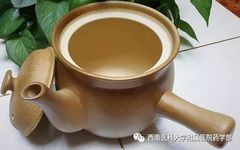
Introduction
As stated in the “Compendium of Materia Medica”: “When taking decoctions, even if the herbs are of high quality and prepared correctly, if the decoction process is careless, with improper water and fire control, the medicine will be ineffective.”
Therefore, the efficacy of Chinese medicine is not only related to the herbs themselves but also closely linked to the preparation methods. Today, let us explore the proper methods for preparing and consuming Chinese herbal decoctions!
Methods for Preparing Chinese Herbal Decoctions
01
Selection of Cooking Utensils
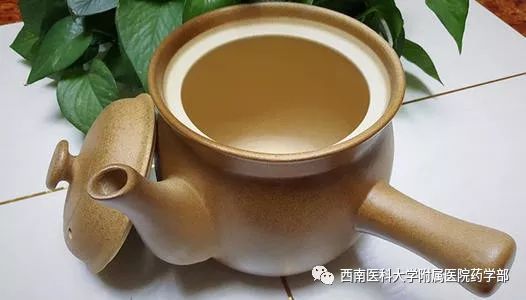
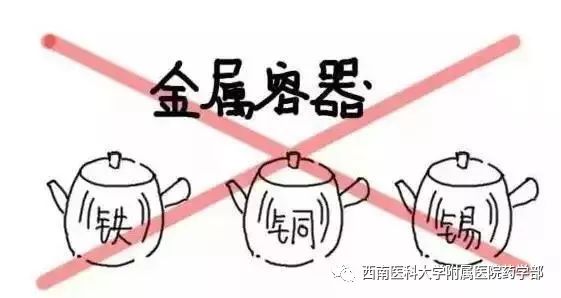
For decocting herbs, it is advisable to use stable materials such as clay pots or ceramic containers. Stainless steel pots are also acceptable; however, avoid using unstable metals like copper, iron, or aluminum, as they may react chemically with the herbal components during the decoction process, reducing efficacy or causing toxic side effects.
02
Selection of Water and Water Volume
Water for Decoction
Generally, any clean drinking water can be used for decocting Chinese herbs. There is no need to wash the herbs before decoction, but they should be soaked appropriately. Most herbs should be soaked in cold or warm water (25-50°C) for about 20-30 minutes, avoiding boiling water. For hard herbs such as roots, tubers, seeds, fruits, minerals, and animal products, the soaking time should be extended. In summer, when temperatures are high, soaking time should not be too long to prevent spoilage.
Water Volume for Decoction
The amount of water added for decoction should be appropriate. A simple method is to gently press the soaked herbal slices flat, adding water to a height of about 2-3 cm above the herbs. For hard, sticky, or long-cooking herbs, slightly more water may be added; for loose herbs or those with easily volatile active ingredients, the water should just cover the herbs.
Additionally, there is a method of adding water at a ratio of 10 times the weight of the herbal slices, with 7 parts of water added for the first decoction and the remaining 3 parts for the second decoction.
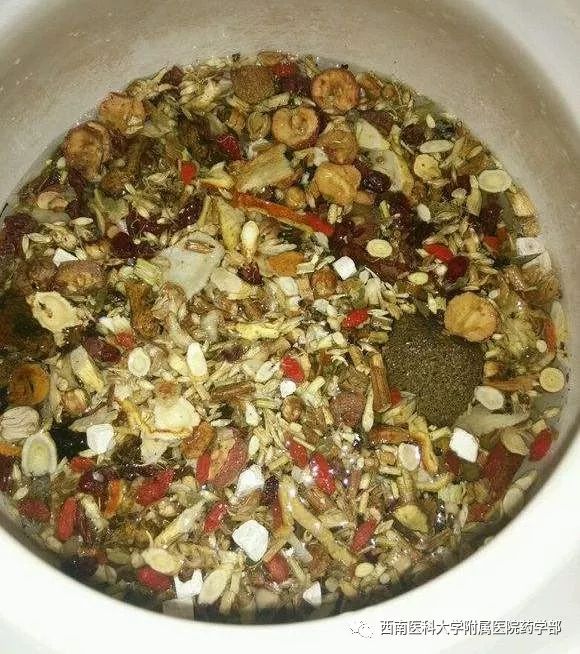
▲Soaking before decoction
▼Pressing flat appropriately
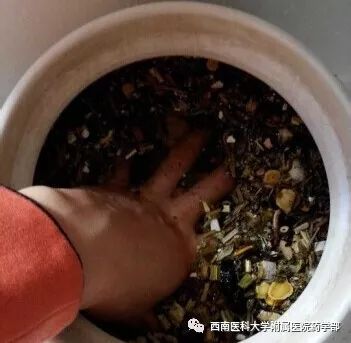
03
Number of Decoctions and Fire Control
Each dose of Chinese herbs is usually decocted 2-3 times. Generally, use high heat (raw fire) to bring to a boil, then switch to low heat (gentle fire) to maintain a simmer, preventing the decoction from boiling over or drying out too quickly.
For exterior-releasing herbs (cold remedies) and other herbs containing volatile components, the first decoction should be boiled for 10-20 minutes, the second for 10-15 minutes, and the third for about 8-10 minutes; for nourishing and regulating herbs, the decoction time should be extended, with the first decoction lasting about 30-35 minutes and the second 20-25 minutes; for hard minerals and shells, the first decoction should be boiled for 30 minutes, with slightly reduced times for the second and third decoctions.
04
Special Decoction Methods
Do you know how to decoct correctly?

1. Pre-decocting
This means extending the decoction time. Certain effective components from minerals and shellfish, such as Long Gu (Dragon Bone), Mu Li (Oyster Shell), Gui Guo (Tortoise Shell), and Bie Jia (Soft-shelled Turtle Shell), require pre-decocting for about 30 minutes before being combined with other herbs. Some herbs that become less toxic with prolonged decoction, such as Chuan Wu (Chuan Wu) and Cao Wu (Cao Wu), should be pre-decocted for about 1 hour until there is no numbness on the tongue, then other herbs can be added for decoction.

2. Late addition
This means shortening the decoction time. Herbs containing volatile oils, which lose effective components when decocted for too long, such as Bo He (Mint), Sha Ren (Cardamom), and Dou Kou (Cardamom), should be added later, after other herbs have been decocted for a certain time, and then decocted together for 5-10 minutes.

3. Bag decoction
For herbal slices with hairs that float on the surface, making decoction difficult, such as Xin Yi (Magnolia Flower) and Xuan Fu Hua (Inula Flower), or for powdered herbs that become sticky and hard to filter, such as Hai Jin Sha (Lygodium) and Pu Huang (Cattail Pollen), it is advisable to use a cloth bag for decoction.

4. Separate decoction
For precious herbs, such as Ren Shen (Ginseng), Xi Yang Shen (American Ginseng), and Ling Yang Jiao (Antelope Horn), they should be decocted separately for 1-2 hours, and then the decoction should be mixed with the main decoction to avoid waste.

5. Melting
This means heating to dissolve. Some gelatinous herbs, such as Ejiao (Donkey-hide Gelatin), Lu Jiao (Deer Antler), and Gui Jiao (Tortoise Shell), should not be decocted with other herbs as they may stick to the pot or burn. They should be placed in water or steamed with a little yellow wine to dissolve before being added to the decoction.

6. Direct consumption
Some herbs that dissolve in water (such as Mang Xiao) and liquid forms (such as honey, syrup) as well as powdered herbs like Ling Yang Jiao (Antelope Horn) and Chen Xiang (Agarwood) do not require decoction and should be taken directly with hot water or herbal juice.
05
Extracting the Decoction
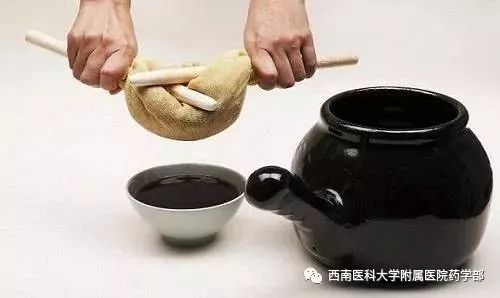
After each decoction, the liquid should be filtered promptly to prevent the effective components from reabsorbing into the herbal residue as the temperature drops, which would affect the efficacy of the Chinese medicine. To avoid waste, it is recommended to squeeze out the juice. This is especially important for herbs that lose effective components at high temperatures or those that are decocted only once. Each dose of Chinese herbs is decocted 2-3 times, with each extraction yielding about 50-200 ml of liquid, which should be mixed and taken in portions.
Methods for Consuming Chinese Herbal Decoctions
01
Timing of Consumption
Oral administration is the primary method of delivery in TCM. Decoctions are typically taken once daily, divided into 2-3 doses, with specific timing determined by gastrointestinal condition, affected areas, and the properties of the herbs.
|
1 |
On an empty stomach Herbs that act on the blood vessels of the limbs should be taken on an empty stomach, such as laxatives, diuretics, and anthelmintics, which should be taken in the morning on an empty stomach. Nourishing herbs should also be taken on an empty stomach. |
|
2 |
Before meals For diseases located below the chest and abdomen, such as stomach, liver, and kidney diseases, the decoction should be taken before meals. Antiemetic herbs should also be taken before meals. |
|
3 |
After meals For diseases located above the chest, such as sore throat, eye diseases, headaches, and dizziness, the decoction should be taken after meals. Some herbs that irritate the gastrointestinal tract, such as those for digestion, should also be taken after meals. |
|
4 |
Before bed Sedative and sleep-aiding herbs should be taken 0.5-1 hour before sleep. Laxatives should be taken before bed to facilitate morning bowel movements. |
|
5 |
Follow medical advice for special formulas Antimalarial herbs should be taken 2 hours before a malaria attack, and for acute illnesses, timing is less strict. |
Special Note
Taking Chinese herbal decoctions before or after meals means consuming them about 0.5-1 hour apart from meal times.
02
Temperature of Consumption
The temperature at which decoctions are consumed may vary based on symptoms and herbs. However, decoctions are generally best taken warm, especially those that may irritate the gastrointestinal tract, and should be shaken before consumption. Warm herbs for treating cold conditions should be taken hot, while exterior-releasing herbs (cold remedies) should also be taken hot. Cold herbs for treating heat conditions should be taken cold, while detoxifying, cooling, and antiemetic herbs should be taken cold.
Conclusion
By employing appropriate decoction methods and suitable consumption practices, we can enhance the efficacy of Chinese herbal decoctions.
Written/Illustrated by Wang Maolin
Source:Pharmacy Department
Edited by: Li Hao
Proofread by: Ren Shiyu
Reviewed by: Wang Yi
News Hotline: 0830-3165027



